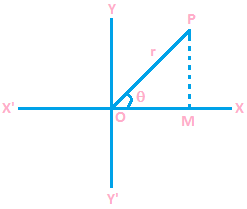Trigonometrical or Polar representation of Complex Numbers
Let z = x + iy is a complex number which is denoted by a point P (x, y) in a complex plane, then OP = |z| and ∠POX = θ = arg (Z).

In ΔPOM,
\(\cos \theta =\frac{OM}{OP}\),
\(\cos \theta =\frac{x}{|z|}\),
Then x = |z| cosθ and θ.
\(\sin \theta =\frac{PM}{OP}\).
\(\sin \theta =\frac{y}{|z|}\).
Then y = |z| sinθ
We know that
Z = x+ iy
Z = |z| cosθ + i |z| sinθ
Z = |z| (cosθ + i sinθ)
Z = r (cosθ + i sinθ)
Where r = |z| and \(\theta ={{\tan }^{-1}}\left( \frac{y}{x} \right)\),
This form of z is known as polar form
In general, polar form is z = r [cos (2nπ + θ) + i sin (2nπ + θ)].
Where,
r = |z|, θ = arg (z) and n ϵ N.
